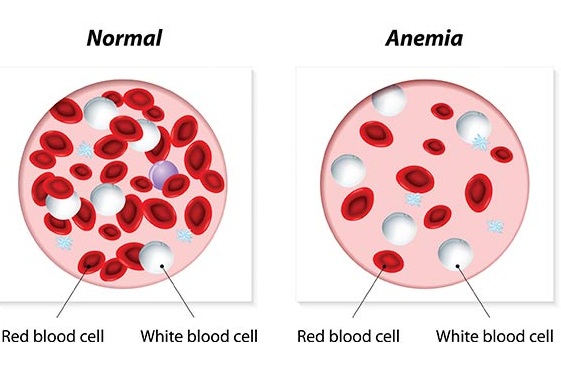
Anemia describes the condition in which the number of red blood cells in the blood is low. For this reason, doctors sometimes describe someone with anemia as having a low blood count. A person who has anemia is called anemic.
Blood is comprised of two parts: a liquid called the plasma and a cellular part. The cellular part contains several different cell types. One of the most important and the most numerous cell types are red blood cells. The other cell types are the white blood cells and platelets. Only red blood cells are discussed in this article. The purpose of the red blood cell is to deliver oxygen from the lungs to other parts of the body.
Red blood cells are produced through a series of complex and specific steps. They are made in the bone marrow (inner part of the femur and pelvic bones that make most of the cells in the blood), and when all the proper steps in their maturation are complete, they are released into the blood stream. The hemoglobin molecule is the functional unit of the red blood cells and is a complex protein structure that is inside the red blood cells. Contrary to most cells in the human body, red blood cells do not have a nucleus (metabolic center of a cell).
Even though the red blood cells (or RBCs) are made within the bone marrow, many other factors are involved in their production. For example, iron is a very important component of the hemoglobin molecule; erythropoietin, a molecule secreted by the kidneys, promotes the formation of red blood cells in the bone marrow.
The following are some key points summarizing anemia and red blood cells:
Having the correct number of red blood cells and prevention of anemia requires cooperation among the kidneys, the bone marrow, and nutrients within the body. If the kidneys or bone marrow are not functioning, or the body is poorly nourished, then normal red blood cell count and function may be difficult to maintain.
Anemia is actually a sign of a disease process rather than bring a disease itself. It is usually classified as either chronic or acute. Chronic anemia occurs over a long period of time. Acute anemia occurs quickly. Determining whether anemia has been present for a long time or whether it is something new, assists doctors in finding the cause. This also helps predict how severe the symptoms of anemia may be. In chronic anemia, symptoms typically begin slowly and progress gradually; whereas in acute anemia symptoms can be abrupt and more distressing.
Red blood cells live about 100 days, so the body is constantly trying to replace them. In adults, red blood cell production occurs in the bone marrow. Doctors try to determine if a low red blood cell count is caused by increased blood loss of red blood cells or from decreased production of them in the bone marrow. Knowing whether the number of white blood cells and/or platelets has changed also helps determine the cause of anemia.
In the United States, 2% to 10% of people have anemia. Other countries have even higher rates of anemia. Young women are twice as likely to have anemia than young men because of regular menstrual bleeding. Anemia occurs in both young people and in old people, but anemia in older people is more likely to cause symptoms and be related to serious, underlying conditions.
In general, there are three major types of anemia, classified according to the size of the red blood cells:
If the red blood cells are smaller than normal, this is called microcytic anemia. The major causes of this type are iron deficiency (low level iron) anemia and thalassemia (inherited disorders of hemoglobin).
If the red blood cells size are normal in size (but low in number), this is called normocytic anemia, such as anemia that accompanies chronic disease or anemia related to kidney disease.
If red blood cells are larger than normal, then it is called macrocytic anemia. Major causes of this type are pernicious anemia and anemia related to alcoholism.